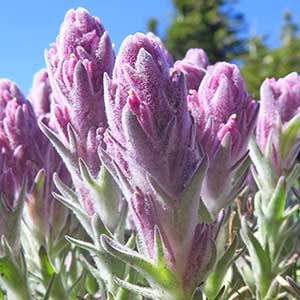Castilleja schizotricha
Castilleja exserta
split hair Indian paintbrush, split-hair paintbrush
castilleja exserta, escobita, exserted Indian paintbrush, owl's clover, purple owl's-clover, purple painted-cup
few to many, ascending to erect, unbranched, hairs dense, appressed-ascending, matted, long, soft, branched, eglandular, ± white-woolly, obscuring surface.
solitary, erect to ascending, unbranched or diffusely branched from near base, hairs spreading, medium length and long, stiff, mixed with short stipitate-glandular ones.
gray-green with hairs, surface green to purple, linear-lanceolate, 0.5–2 cm, not fleshy, margins plane, ± involute, 0(–3)-lobed, apex acute to acuminate, sometimes rounded;
lobes sometimes divergent, spreading-ascending, narrowly linear, apex acute.
green, sometimes purple to brownish, linear or ovate to orbicular in outline, (0.8–)1–5(–7.7) cm, not fleshy, margins plane, involute, (0–)3–9(–11)-lobed, sometimes with secondary lobing, apex acuminate to rounded or acute;
lobes spreading, filiform or linear to narrowly spatulate, apex acute to acuminate or rounded.
3–8 × 1–2 cm;
bracts purple, lavender, pinkish, or dusty red throughout, sometimes greenish throughout or proximally greenish, distally colored as above, obscured by hairs, lanceolate, 3(–5)-lobed;
lobes ascending to erect, linear to oblanceolate, short, arising near or above mid length, apex obtuse.
1.5–20 × 2–4 cm;
bracts proximally greenish, dark purple, brownish purple, or white, distally pink, lavender, magenta, light purple, or white on lobe apices, lanceolate to elliptic or narrowly ovate, (3–)5(–9)-lobed, often with 2–4 secondary lobes;
lobes ascending to spreading, linear to filiform or narrowly spatulate, medium length to long, arising below or above mid length, apex rounded to acute.
straight, 15–20 mm;
tube 8–9 mm;
beak included to slightly exserted, adaxially purple or pink, 3.9–5 mm, densely puberulent with white, woolly hairs;
abaxial lip deep purple, inconspicuous, pouched, pouches shallow, 3–5 mm, 80–100% as long as beak;
teeth upright-ascending, reduced, appearing white, 1.5–2 mm.
straight, 12–33 mm;
tube 7–20 mm;
beak slightly exserted, hooked near apex, adaxially pink-purple to magenta, rarely white, 5–13 mm, margins colored as bracts, densely villous-hairy;
abaxial lip proximally pink, purple, or magenta, rarely yellow or white, with maroon or deep purple distal to that and white to yellow or pink distally, often with purple spots, distal pale color often aging deep pink or deep red, strongly inflated, pouches 3, 3–8 mm wide, 3–4 mm deep, 3–9 mm, 67–80% as long as beak;
teeth erect, white, yellow, or purple, often with purple or maroon spots, 0.5–2 mm.
colored as bracts, 11–18 mm;
abaxial and adaxial clefts 3.5–6 mm, 33–50% of calyx length, all 4 clefts subequal, lateral 4–6 mm, 33–50% of calyx length;
lobes linear, apex acute.
colored as bracts, 10–26 mm;
abaxial clefts 4–12 mm, adaxial 9–18 mm, abaxial ca. 50% of calyx length, adaxial ca. 67% of calyx length, at least adaxial deeper than others, lateral 2.5–9 mm, 15–45% of calyx length;
lobes linear (to narrowly oblanceolate), apex rounded to acute.
with spreading, long, soft hairs.
= 24.
Castilleja schizotricha
Castilleja exserta
Castilleja schizotricha is a rare species restricted to high elevations in the mountains in Siskiyou and Trinity counties in northwestern California and in Jackson and western Klamath counties in southwestern Oregon. See the discussion of 6. C. arachnoidea for morphological differences between it and C. schizotricha, as the two are sometimes confused. Though their ranges overlap, they do not appear to hybridize.
(Discussion copyrighted by Flora of North America; reprinted with permission.)
Varieties 3 (3 in the flora).
In addition to the characters in the key, Castilleja exserta is distinguished from the similar C. densiflora by its conspicuously hairy and apically hooked beak. As a result, the capitate stigma is exserted more or less horizontally from the corolla beak. In contrast, C. densiflora has an unhooked, inconspicuously puberulent beak, from which the stigma emerges more vertically. Castilleja exserta hybridizes with C. attenuata in southern California and with C. lineariloba in central California, and it reportedly crosses occasionally with C. densiflora in southern California.
(Discussion copyrighted by Flora of North America; reprinted with permission.)
1. Abaxial lips of corollas deep red-purple proximally, with distal 1/4 bright yellow to yellow-orange, becoming orange or red after anthesis; w Mojave Desert, California. | var. venusta |
1. Abaxial lips of corollas variably colored, proximally pink to deep red-purple or white, with distal 1/4–1/3 white, yellow, or yellow-orange; widespread in Arizona and California, rare in New Mexico or limited to the coastal regions of California. | → 2 |
2. Bracts usually less than 5 mm wide, lobes filiform to linear; inland and near-coastal grasslands and meadows; Arizona, w California, sw New Mexico. | var. exserta |
2. Bracts 5–7 mm wide, lobes linear to narrowly spatulate; coastal dunes and bluffs; California. | var. latifolia |
- Local floras:
CA,
OR,
WA
- Local Web sites:
CalFlora,
CalPhotos,
Flora NW,
PNW Herbaria
WildflowerSearch
iNaturalist (observations)
USDA Plants Database
- LBJ Wildflower Center
- SEINet
- Plants of the World Online
- Encyclopedia of Life
- Wikipedia
- Google Image Search


